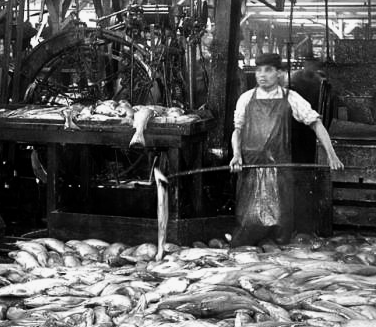Edmund A. Smith (inventor) on:
[Wikipedia]
[Google]
[Amazon]
Edmund Augustine "Ned" Smith (March 17, 1870 – June 3, 1909) was an American entrepreneur and inventor who helped to industrialize the fish packing and canning industry.
 Smith's invention severely impacted the workers of the seafood industry, forcing thousands of seafood butchers and packers to find other sources of employment. However, Smith's invention increased cannery profits and led to the growth of the seafood industry.
Smith's invention gave him considerable wealth. Smith was invited to display his invention at the
Smith's invention severely impacted the workers of the seafood industry, forcing thousands of seafood butchers and packers to find other sources of employment. However, Smith's invention increased cannery profits and led to the growth of the seafood industry.
Smith's invention gave him considerable wealth. Smith was invited to display his invention at the
Early life
Smith was born in 1870 inMiddlesex County, Ontario
Middlesex County is a primarily rural county and Census divisions of Canada, census division in Southwestern Ontario, Canada. Landlocked, the county is bordered by Huron County, Ontario, Huron and Perth County, Ontario, Perth counties on the north ...
, the son of Robert Frederick Smith (1832–1916) and Mary Charlotte Garnett Smith (1845–1899) By 1895, Smith had moved to Seattle, Washington
Seattle ( ) is the List of municipalities in Washington, most populous city in the U.S. state of Washington (state), Washington and in the Pacific Northwest region of North America. With a population of 780,995 in 2024, it is the List of Unit ...
.
Career
Smith was an investor in various fish canning and brick-making businesses in the Seattle area. He owned the Smith Manufacturing Company, a waterfront workshop in the city where he developed and manufactured various inventions. In 1903, Smith invention a mechanized fish-butchering machine which he named the '' Iron Chink,'' which gutted and cleaned salmon for canning at a rate of 55 times faster than humanbutchers
A butcher is a person who may slaughter animals, dress their flesh, sell their meat, or participate within any combination of these three tasks. They may prepare standard cuts of meat and poultry for sale in retail or wholesale food establishme ...
. Smith obtained a U.S. patent for the machine in 1905 and a patent in Canada the following year. Other patented inventions of Smith's included a weight testing machine and composite pile.
The naming of the machine is seen by some as symbolic anti-Chinese racism during the early 1900s
File:1900s decademontage2.png, 335px, From left, clockwise: The Wright brothers achieve the Wright Flyer, first manned flight with a motorized airplane, in Kitty Hawk, North Carolina, Kitty Hawk in 1903; A missionary points to the severed hand of ...
. However, some historians have held that Smith named the machine due to his regard for Chinese butcher
A butcher is a person who may Animal slaughter, slaughter animals, dress their flesh, sell their meat, or participate within any combination of these three tasks. They may prepare standard cuts of meat and poultry for sale in retail or wholesale ...
crews.
 Smith's invention severely impacted the workers of the seafood industry, forcing thousands of seafood butchers and packers to find other sources of employment. However, Smith's invention increased cannery profits and led to the growth of the seafood industry.
Smith's invention gave him considerable wealth. Smith was invited to display his invention at the
Smith's invention severely impacted the workers of the seafood industry, forcing thousands of seafood butchers and packers to find other sources of employment. However, Smith's invention increased cannery profits and led to the growth of the seafood industry.
Smith's invention gave him considerable wealth. Smith was invited to display his invention at the Alaska–Yukon–Pacific Exposition
The Alaska–Yukon–Pacific Exposition, acronym AYP or AYPE, was a world's fair held in Seattle in 1909 publicizing the development of the Pacific Northwest. It was originally planned for 1907 to mark the 10th anniversary of the Klondike Gold ...
in 1909.
Personal life and death
Smith marriedWisconsin
Wisconsin ( ) is a U.S. state, state in the Great Lakes region, Great Lakes region of the Upper Midwest of the United States. It borders Minnesota to the west, Iowa to the southwest, Illinois to the south, Lake Michigan to the east, Michig ...
native Mary Gertrude Peterson in 1898. They had two children, Helen (b. 1899) and Wallace (b. 1902).
In June 1909 at the age of 39, Smith died in an automobile accident on his way to the opening of the Alaska–Yukon–Pacific Exposition. He is buried at Lake View Cemetery
Lake View Cemetery is a Private property, privately owned, Nonprofit organization, nonprofit Rural cemetery, garden cemetery located in the cities of Cleveland, Cleveland Heights, Ohio, Cleveland Heights, and East Cleveland, Ohio, East Cleveland ...
in Seattle.
Legacy
An exhibit about Smith, including his "Iron Chink" invention, is displayed at theMuseum of History & Industry
The Museum of History & Industry (MOHAI) is a history museum in the South Lake Union neighborhood of Seattle, Washington, United States. It is the largest private heritage organization in Washington state, maintaining a collection of nearly four ...
.
Smith's invention is still used today, now known as the "Iron Butcher." His invention is regarded as an influential contribution to the growth of the warehousing, shipping, packing, and other cannery activities of the modern seafood industry, especially the salmon canning industry.
References
{{DEFAULTSORT:Smith, Edmund A. 1870 births 1909 deaths 20th-century American businesspeople American fishermen American food industry businesspeople Inventors from Washington (state) Businesspeople from Seattle People from Middlesex County, Ontario Businesspeople from Ontario Canadian emigrants to the United States Road incident deaths in Washington (state) Burials at Lake View Cemetery (Seattle)